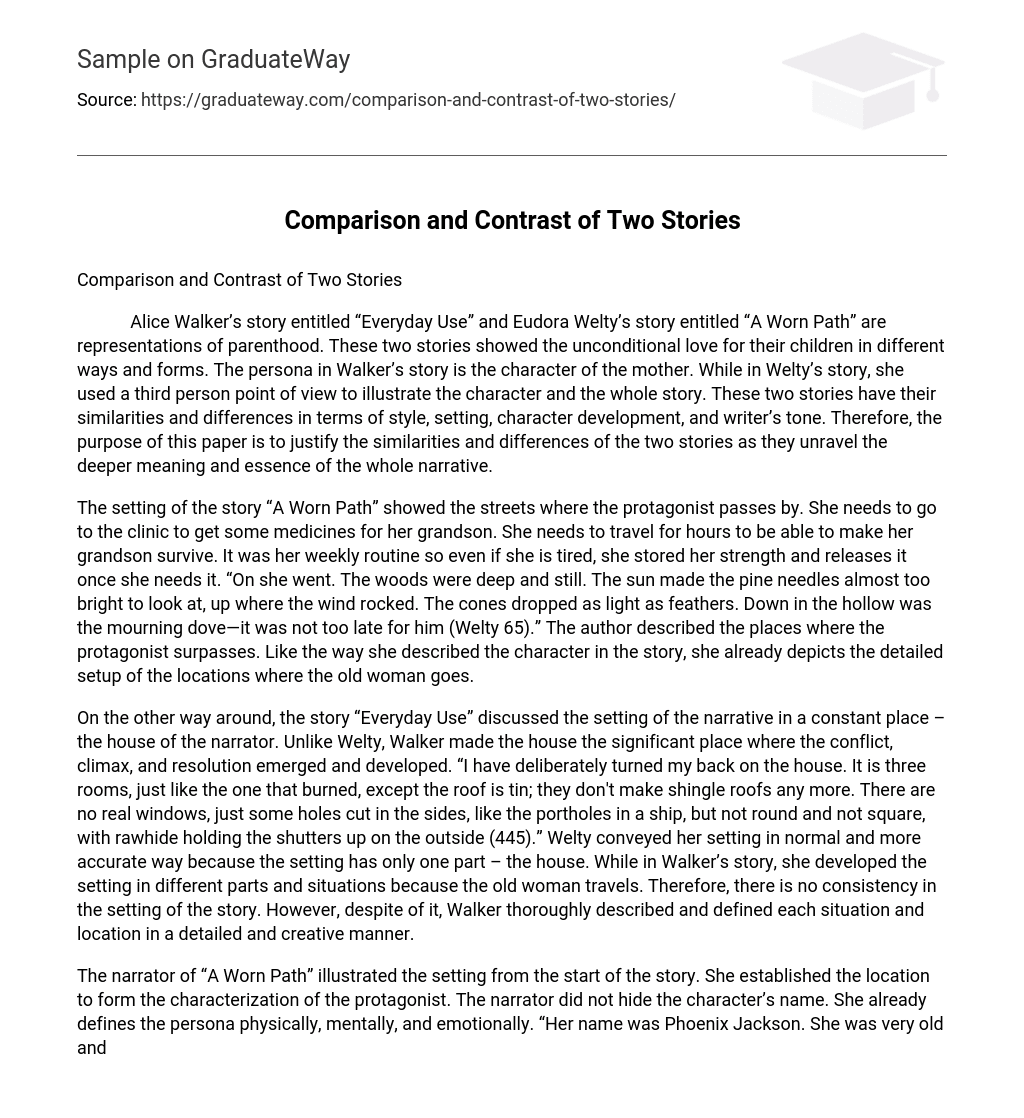Alice Walker’s story entitled Everyday Use” and Eudora Welty’s story entitled “A Worn Path” both explore the theme of parenthood. Each story portrays a mother’s unconditional love for her child in different ways. In Walker’s story, the mother is the main character, while Welty uses a third-person point of view to tell her tale.
Despite their differences in style and perspective, these two stories share similarities in setting, character development, and tone. This paper aims to examine these similarities and differences to uncover the deeper meaning behind each narrative.
The story A Worn Path” takes place on the streets that the protagonist travels through in order to reach the clinic and obtain medicine for her grandson. Despite having to travel for hours, it is a weekly routine that she endures in order to save her grandson’s life. Even when tired, she stores her strength and uses it when needed. As described by the author, “On she went. The woods were deep and still. The sun made the pine needles almost too bright to look at, up where the wind rocked.” The author provides vivid descriptions of each location that the old woman passes through.
On the other hand, the story Everyday Use” discusses the narrative’s setting in a constant place – the narrator’s house. Unlike Welty, Walker made the house a significant place where conflict, climax, and resolution emerged and developed. “I have deliberately turned my back on the house. It is three rooms, just like the one that burned, except the roof is tin; they don’t make shingle roofs anymore. There are no real windows, just some holes cut in the sides like portholes in a ship but not round and not square with rawhide holding up shutters on the outside” (445). Welty conveyed her setting normally and accurately because it only has one part -the house- while Walker developed different parts of her story’s setting through various situations as an old woman travels. Therefore there is no consistency in her story’s setting. Despite this fact though, Walker thoroughly described each situation and location creatively and in detail.
The narrator of “A Worn Path” establishes the setting from the beginning of the story, which helps to develop the protagonist’s character. The character’s name, Phoenix Jackson, is revealed along with her physical, mental, and emotional attributes. She was very old and small and she walked slowly in the dark pine shadows, moving a little from side to side in her steps, with the balanced heaviness and lightness of a pendulum in a grandfather clock” (64). The conflict does not stem from Phoenix’s character but rather how she handles situations around her. The author develops an image of old age and weakness; however, despite these aspects, there is irony and parallelism between old age/hastiness and weakness/struggle. Welty portrays Phoenix’s mind as hasty despite her physical weaknesses. Despite struggling to achieve her goal – getting medicine for her grandson – Phoenix perseveres.
On the other hand, Walker’s story does not give the mother a name. As the protagonist of the story, her perception and perspective are important to its development. In real life, I am a large, big-boned woman with rough, man-working hands. In winter I wear flannel nightgowns to bed and overalls during the day. I can kill and clean a hog as mercilessly as a man. My fat keeps me hot in zero weather” (Walker 444). This reveals her qualities as an individual and a mother to her children. However, even though she portrays herself as an individual with power and strength over her two daughters, she remains weak due to financial circumstances that limit her abilities. Unlike Welty’s story, Walker does not provide insight into her character’s personality or individuality beyond being depicted solely as a mother without desires for herself.
When comparing the writer’s tone in these two stories, it is clear that Welty used a formal and deep tone while Walker used a light and soft tone. This is due to the fact that Welty utilized a third person point of view, requiring her to use words that lacked emotion so as not to detract from the protagonist’s feelings. For instance, in A Worn Path,” Phoenix hears dogs fighting and a gunshot but remains stoic: “But she was slowly bending forward by that time, further and further forward, the lids stretched down over her eyes, as if she were doing this in her sleep” (67).
In contrast, Walker uses the character of the mother as narrator which allows for more emotional depth. In “Everyday Use,” readers can attach themselves to the story because they are experiencing it through the mother’s eyes: “Maggie smiled; maybe at the sunglasses. But a real smile, not scared…And then the two of us sat there just enjoying until it was time to go in” (449). This direct connection with characters’ emotions is something Welty’s story lacks.
Overall, Welty’s story has a more serious tone due to its depiction of character and setting whereas Walker opts for lighter attacks on characterizations making them easier for readers to understand.
When it comes to the style of the story, both authors focused on the narrative rather than dialogues. The dialogues serve only as justifications for their claims, but not as a definite composition of the story as a whole. Welty and Walker are similar in style because they portray women in society and their families. They discuss how women show love towards their families despite weakness, old age, deprivation, and discrimination. Physical and environmental incapacities do not hinder characters’ responsibilities towards loved ones. This is the authors’ style and form of attack in their stories. Although simple, they create significant meanings of womanhood in society.
Works Cited.
Walker, Alice. Everyday Use.” 1973. Pp. 443-449.
Welty, Eudora. A Worn Path.” pp. 64-69, 1941.





